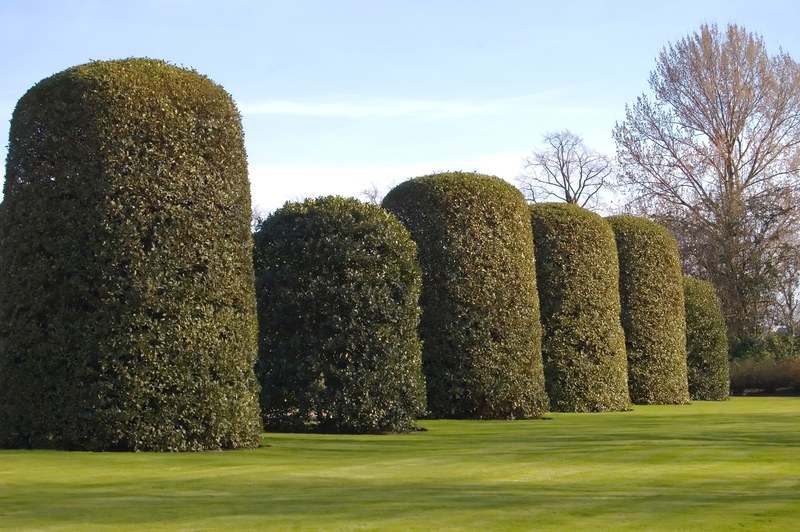Evergreen Climbers for Shade: Nature's Remedy for Shady Spots
Posted on 01/09/2025
Evergreen Climbers for Shade: Nature's Remedy for Shady Spots
Shady gardens often present a unique challenge for gardening enthusiasts and homeowners. Such areas can feel uninspiring and underutilized, yet these landscapes offer a fantastic opportunity. By introducing evergreen climbers, you can add year-round color, texture, and even scent to places where the sun rarely shines. If you're seeking lush foliage and perpetual beauty, then exploring the best climbing evergreens for shade is the solution you've been waiting for! This comprehensive guide will help you select, plant, and care for shade-loving evergreen vines, transforming even the gloomiest garden corners into stunning verdant retreats.
Why Choose Evergreen Climbers for Shade?
Evergreen climbing plants are an outstanding choice for shady spots for a multitude of reasons:
- Year-Round Interest: Unlike deciduous varieties, evergreen climbers retain their foliage through winter, maintaining vital garden structure and color.
- Privacy and Screening: These climbers can quickly cover fences, walls, arbors, and pergolas, ensuring privacy even in the colder months when most plants go bare.
- Wildlife Habitat: Their dense foliage offers shelter and sometimes berries for birds and beneficial insects.
- Low Maintenance: Many shade-tolerant evergreen vines are naturally pest- and disease-resistant.
By adding these versatile plants, you're ensuring that every part of your garden is healthy, beautiful, and alive regardless of the season.

Top 10 Evergreen Climbers for Shady Gardens
Not every evergreen climber thrives in shade. Below are some of the best shade-tolerant evergreen climbers that flourish away from the sun.
1. Hedera helix (English Ivy)
- Sun/Shade: Thrives in full shade to part sun
- Soil: Adaptable to many soil types
- Growth: Fast-growing, self-clinging
English Ivy is a classic evergreen vine for shade. Its glossy leaves come in many shapes and sizes, and it quickly covers unsightly areas. Ideal for woodland gardens, it can be kept in check with regular pruning to prevent invasiveness.
2. Trachelospermum jasminoides (Star Jasmine)
- Sun/Shade: Tolerates shade, thrives in part shade
- Features: Fragrant white flowers in summer
- Soil: Well-drained soil preferred
This star jasmine is prized for its sweet-scented flowers and glossy foliage. While it loves sun, it will still flower and grow well in lightly shaded locations -- ideal for north-facing walls and pergolas.
3. Lonicera henryi (Henry's Honeysuckle)
- Sun/Shade: Flourishes in dappled or deep shade
- Flowering: Tubular yellow and red flowers
- Benefits: Attracts hummingbirds and pollinators
Henry's Honeysuckle is a superb evergreen climber for shaded fences, as its foliage remains lush and its blooms add striking color. The plant is easy to train and maintain, making it a gardener's favorite.
4. Euonymus fortunei (Wintercreeper)
- Sun/Shade: Grows in full shade or sun
- Growth: Climbing or ground cover habit
Wintercreeper is a versatile evergreen climbing shrub for shade with attractive variegated leaves. It clings to supports or can be allowed to cascade as ground cover, perfect for brightening dark areas of your landscape.
5. Clematis armandii (Evergreen Clematis)
- Sun/Shade: Partial shade preferred
- Features: Large, fragrant white flowers in early spring
This plant offers show-stopping blooms and evergreen foliage that looks great year-round. Evergreen Clematis is perfect for north-east facing trellises or shaded archways, offering both beauty and privacy.
6. Pyracantha rogersiana ('Orange Glow')
- Sun/Shade: Grows in full to partial shade
- Features: Bright orange berries in autumn and winter
- Uses: Trained for walls and fences
This firethorn's brilliant berries and spiny stems make a valuable addition for wildlife. Although more often grown as a shrub, it is easily trained as a wall climber in shady spots.
7. Hedera colchica (Persian Ivy)
- Sun/Shade: Full shade to partial shade
- Foliage: Extra-large leaves, deeply glossy
For dramatic foliage, Persian Ivy is hard to beat. This evergreen climbing vine adapts well to challenging shady environments and quickly covers large areas.
8. Garrya elliptica (Silk Tassel Bush)
- Sun/Shade: Prefers partial shade
- Features: Long catkins in winter
The Garrya's striking winter catkins light up even the darkest months, making it an attractive option for climbing evergreens for shade. Can be trained against sheltered, shaded walls for maximum effect.
9. Passiflora caerulea (Blue Passionflower)
- Sun/Shade: Tolerates part shade
- Blooms: Exotic blue and white flowers in summer
Blue passionflower isn't strictly evergreen in colder climates, but in sheltered or mild gardens it can retain its unique foliage. Its ability to handle partial shade and provide remarkable blooms is unrivaled.
10. Jasminum nudiflorum (Winter Jasmine)
- Sun/Shade: Grows in partial to full shade
- Flowers: Bright yellow blooms in winter
Winter jasmine's vibrant flowers appear early, creating interest long before spring. It grows vigorously in shade and is easy to prune and manage.
Designing With Evergreen Climbers: Maximizing Impact in Shady Areas
It's not enough to just choose the best evergreen climbers for shade -- how you position, train, and combine them will determine your garden's appeal. Here are expert tips for using climbers to best effect in shaded gardens:
Layer Foliage for Texture
- Mix leaf shapes and colors: Pair glossy ivies and star jasmines with variegated or textured evergreens for extra depth.
- Add flowering climbers: Select varieties like Clematis armandii or passionflower for seasonal bursts of color.
Use Structural Supports
- Install trellises, arches, or pergolas: These create vertical interest and maximize growth in otherwise uninspiring corners.
- Choose durable materials: Shady areas are often damper, so use rot-resistant wood, metal, or vinyl supports.
Combine With Other Shade Plants
- Create mixed borders: Underplant climbers with ferns, hostas, or hellebores.
- Encourage a woodland vibe: Bluebells, snowdrops, and native shade perennials create a layered woodland understory.
Evergreen climbing plants are also excellent for adding privacy in urban gardens and can be used to soften harsh brickwork or fencing.
Planting and Caring for Evergreen Climbers in Shade
Proper planting is vital for your chosen shade-loving evergreen vines to thrive. Here's how to get them off to the best start:
Soil Preparation
- Enrich the soil: Incorporate compost or leaf mold to boost organic content and improve moisture retention.
- Ensure good drainage: While these climbers love moisture, soggy soil can lead to root rot. If soil is heavy clay, amend with grit or plant in raised beds.
Planting Tips
- Dig a generous hole: The planting hole should be twice the width and equal depth of the rootball.
- Add nutrients: Mix in slow-release fertilizer for healthy root development.
- Plant at an angle: For wall climbers, position the plant so it leans slightly towards the support.
Training and Support
- Guide growth: Secure stems loosely to supports using soft ties or garden twine.
- Prune regularly: Trim damaged or wayward shoots annually to keep plants healthy and manageable.
Ongoing Maintenance
- Watering: Water regularly during dry spells, especially until plants are established.
- Mulching: Apply a thick mulch of bark or compost to conserve moisture and suppress weeds.
- Feeding: Feed with a balanced fertilizer in spring to promote lush growth.
Frequently Asked Questions: Evergreen Climbers for Shady Sites
Can evergreen climbers grow in deep shade?
Yes! Species like English Ivy and Wintercreeper are exceptionally tolerant of deep shade. Most evergreen climbers prefer partial to dappled shade but will adapt to deeper shade with slightly slower growth.
How do I encourage flowering in shade?
Choose varieties known for blooming in lower light, such as Star Jasmine and Clematis armandii. Ensure they receive morning sun if possible and feed annually with a high-potassium fertilizer for best results.
Are these climbers suitable for small gardens?
Absolutely! Many evergreen vines for shade can be kept compact with pruning and are well-suited to container gardening. They're ideal for covering fences and providing vertical greenery where space is limited.
Which evergreen climbers for shade are low-maintenance?
English Ivy, Euonymus fortunei, and Persian Ivy are among the easiest to maintain, requiring little pruning once established and rarely suffering from pests or diseases.

The Environmental and Practical Benefits of Evergreen Climbers in Shady Spaces
Planting evergreen climbing plants for shade is not just an aesthetic choice -- it has practical and environmental benefits:
- Reduces soil erosion: Dense foliage prevents rain splash and soil loss.
- Improves air quality: Green leaves filter pollutants and trap dust.
- Boosts biodiversity: Provides habitat for garden wildlife throughout the year.
- Cools buildings: Climbers trained against walls insulate and reduce heat in the summer months.
These benefits enhance both the health and value of your garden and home.
Conclusion: Transforming Shady Corners Into Year-Round Havens
Evergreen climbers for shade create vibrant, living tapestries in otherwise forgotten corners of your garden. Whether you're looking for a privacy screen, ground cover for a woodland border, or simply year-round beauty, shade-loving evergreen climbing plants are a smart, sustainable, and rewarding choice. By selecting the right species, preparing soil diligently, and investing in solid supports, you'll enjoy a lush, green retreat whatever the weather or season.
Reimagine your shady garden spots -- let nature's most adaptable climbers do the hard work, and discover the hidden beauty of your shade gardens today!

